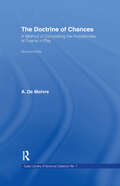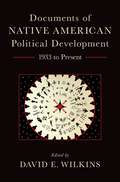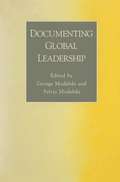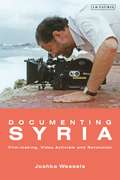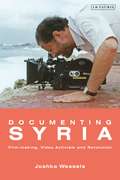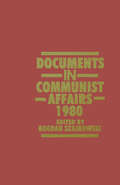- Table View
- List View
Doctors and Demonstrators: How Political Institutions Shape Abortion Law in the United States, Britain, and Canada
by Drew HalfmannSince Roe v. Wade, abortion has continued to be a divisive political issue in the United States. In contrast, it has remained primarily a medical issue in Britain and Canada despite the countries’ shared heritage. Doctors and Demonstrators looks beyond simplistic cultural or religious explanations to find out why abortion politics and policies differ so dramatically in these otherwise similar countries. Drew Halfmann argues that political institutions are the key. In the United States, federalism, judicial review, and a private health care system contributed to the public definition of abortion as an individual right rather than a medical necessity. Meanwhile, Halfmann explains, the porous structure of American political parties gave pro-choice and pro-life groups the opportunity to move the issue onto the political agenda. A groundbreaking study of the complex legal and political factors behind the evolution of abortion policy, Doctors and Demonstrators will be vital for anyone trying to understand this contentious issue.
Doctors and Demonstrators: How Political Institutions Shape Abortion Law in the United States, Britain, and Canada
by Drew HalfmannSince Roe v. Wade, abortion has continued to be a divisive political issue in the United States. In contrast, it has remained primarily a medical issue in Britain and Canada despite the countries’ shared heritage. Doctors and Demonstrators looks beyond simplistic cultural or religious explanations to find out why abortion politics and policies differ so dramatically in these otherwise similar countries. Drew Halfmann argues that political institutions are the key. In the United States, federalism, judicial review, and a private health care system contributed to the public definition of abortion as an individual right rather than a medical necessity. Meanwhile, Halfmann explains, the porous structure of American political parties gave pro-choice and pro-life groups the opportunity to move the issue onto the political agenda. A groundbreaking study of the complex legal and political factors behind the evolution of abortion policy, Doctors and Demonstrators will be vital for anyone trying to understand this contentious issue.
The Doctrine of Chances: A Method of Calculating the Probabilities of Events in Play
by A.De MoivreFirst Published in 1967. In the year 1716 Abraham de Moivre published his Doctrine of Chances, in which the subject of Mathematical Probability took several long strides forward. Includes a series of problems of progressive interest, followed by full solutions and an afterword by H.M. Walker.
The Doctrine of Chances: A Method of Calculating the Probabilities of Events in Play
by A.De MoivreFirst Published in 1967. In the year 1716 Abraham de Moivre published his Doctrine of Chances, in which the subject of Mathematical Probability took several long strides forward. Includes a series of problems of progressive interest, followed by full solutions and an afterword by H.M. Walker.
Doctrine, the Alliance and Arms Control: (pdf) (International Institute for Strategic Studies Conference Papers)
by Robert O'NeillDOCUM OF NATIVE AMER POLIT DEVEL C: 1933 to Present
by David E. WilkinsBefore Europeans arrived in what is now known as the United States, over 600 diverse Native nations lived on the same land. This encroachment and subsequent settlement by Americans forcibly disrupted the lives of all indigenous peoples and brought about staggering depopulation, loss of land, and cultural, religious, and economic changes. These developments also wrought profound changes in indigenous politics and longstanding governing institutions. David E. Wilkins' two-volume work Documents of Native American Political Development traces how indigenous peoples have maintained and continued to exercise a significant measure of self-determination contrary to presumptions that such powers had been lost, surrendered, or vanquished. Volume One provided materials from the 1500s to 1933. This collection of primary source and other documents begins in 1933 and spans the subsequent eight decades. Broadly, the volume organizes this period into the following distinctive eras: indigenous political resurgence and reorganization (1934 to 1940s); indigenous termination/relocation (1940s to 1960s); indigenous self-determination (1960s to 1980s); and indigenous self-governance (1980s to present). Wilkins presents documents including the governing arrangements Native nations created and adapted that are comparable to formal constitutions; international and interest group records; statements by prominent Native and non-Native individuals; and sources featuring important innovations that display the political acumen of Native nations. The documents are arranged chronologically, and Wilkins provides concise, introductory essays to each document, placing them within the proper context. Each introduction is followed by a brief list of suggestions for further reading. This continued examination of fascinating and relatively unknown indigenous history, from a number of influential legal and political writings to the formal constitutions crafted since the American intervention of the Indian Reorganization Act of 1934, will be an invaluable resource for scholars and students of the history, law, and political development of Native peoples.
A Documentary Study of Hendrik De Man, Socialist Critic of Marxism (PDF)
by Hendrik De Man Peter DodgeIn this collection of excerpts from the essential works of Hendrik de Man (1885-1953), Peter Dodge reinstates in historical consciousness this pioneer sociologist of the European socialist movement and of labor in industrial society. Regarded before World War II as pre-eminent among socialist theoreticians, comparable to Marx himself, de Man fell into obscurity when his equivocal neutralist stance during the Occupation of his native Belgium undermined his political legitimacy. Yet de Man's observations on the class order of capitalist society, on the difficulties of establishing effective industrial democracy, and on the nature of industrial society may be even more relevant today than they were in early twentieth-century Europe. While largely accepting the Marxist analysis of capitalism, de Man also drew attention to the unacknowledged collapse of many of its assumptions. Insofar as capitalism evolved in ways that Marx had not foreseen, de Man partially attributes the fate of socialism to the limitations of Marxism's nineteenth-century mode of analysis. Selecting from the seventeen books, forty-odd brochures, and some four hundred articles that comprise de Man's works, the editor chooses those passages that are of primary significance for dc Man's intellectual development and for his contribution to social analysis. In addition to explanatory headnotes and an Introduction to de Man's life, the volume contains a selective bibliography of primary and secondary material.Originally published in 1979.The Princeton Legacy Library uses the latest print-on-demand technology to again make available previously out-of-print books from the distinguished backlist of Princeton University Press. These editions preserve the original texts of these important books while presenting them in durable paperback and hardcover editions. The goal of the Princeton Legacy Library is to vastly increase access to the rich scholarly heritage found in the thousands of books published by Princeton University Press since its founding in 1905.
Documenting Global Leadership
by George ModelskiThe book traces the evolution of world politics through documents that illustrate the responsibilities, burdens and opportunities of global leadership.
Documenting Syria: Film-making, Video Activism and Revolution
by Josepha Ivanka WesselsSyria is now one of the most important countries in the world for the documentary film industry. Since the 1970s, Syrian cinema masters played a defining role in avant-garde filmmaking and political dissent against authoritarianism. After the outbreak of violence in 2011, an estimated 500,000 video clips were uploaded making it one of the first YouTubed revolutions in history. This book is the first history of documentary filmmaking in Syria. Based on extensive media ethnography and in-depth interviews with Syrian filmmakers in exile, the book offers an archival analysis of the documentary work by masters of Syrian cinema, such as Nabil Maleh, Ossama Mohammed, Mohammed Malas, Hala Al Abdallah, Hanna Ward, Ali Atassi and Omar Amiralay. Joshka Wessels traces how the works of these filmmakers became iconic for a new generation of filmmakers at the beginning of the 21st century and maps the radical change in the documentary landscape after the revolution of 2011. Special attention is paid to the late Syrian filmmaker and pro-democracy activist, Bassel Shehadeh, and the video-resistance from Aleppo and Raqqa against the regime of President Bashar al-Assad and the Islamic State. An essential resource for scholars of Syrian Studies, this book will also be highly relevant to the fields of media & conflict research, anthropology and political science.
Documenting Syria: Film-making, Video Activism and Revolution
by Josepha Ivanka WesselsSyria is now one of the most important countries in the world for the documentary film industry. Since the 1970s, Syrian cinema masters played a defining role in avant-garde filmmaking and political dissent against authoritarianism. After the outbreak of violence in 2011, an estimated 500,000 video clips were uploaded making it one of the first YouTubed revolutions in history. This book is the first history of documentary filmmaking in Syria. Based on extensive media ethnography and in-depth interviews with Syrian filmmakers in exile, the book offers an archival analysis of the documentary work by masters of Syrian cinema, such as Nabil Maleh, Ossama Mohammed, Mohammed Malas, Hala Al Abdallah, Hanna Ward, Ali Atassi and Omar Amiralay. Joshka Wessels traces how the works of these filmmakers became iconic for a new generation of filmmakers at the beginning of the 21st century and maps the radical change in the documentary landscape after the revolution of 2011. Special attention is paid to the late Syrian filmmaker and pro-democracy activist, Bassel Shehadeh, and the video-resistance from Aleppo and Raqqa against the regime of President Bashar al-Assad and the Islamic State. An essential resource for scholars of Syrian Studies, this book will also be highly relevant to the fields of media & conflict research, anthropology and political science.
Documenting World Politics: A Critical Companion to IR and Non-Fiction Film (Popular Culture and World Politics)
by Casper Sylvest Rens Van MunsterAs a central component of contemporary culture, films mirror and shape political debate. Reflecting on this development, scholars in the field of International Relations (IR) increasingly explore the intersection of TV series, fiction film and global politics. So far, however, virtually no systematic scholarly attention has been given to documentary film within IR. This book fills this void by offering a critical companion to the subject aimed at assisting students, teachers and scholars of IR in understanding and assessing the various ways in which documentary films matter in global politics. The authors of this volume argue that much can be gained if we do not just think of documentaries as a window on or intervention in reality, but as a political epistemology that – like theories – involve particular postures, strategies and methodologies towards the world to which they provide access. This work will be of great interest to students and scholars of international relations, popular culture and world politics and media studies alike.
Documenting World Politics: A Critical Companion to IR and Non-Fiction Film (Popular Culture and World Politics)
by Casper Sylvest Rens Van MunsterAs a central component of contemporary culture, films mirror and shape political debate. Reflecting on this development, scholars in the field of International Relations (IR) increasingly explore the intersection of TV series, fiction film and global politics. So far, however, virtually no systematic scholarly attention has been given to documentary film within IR. This book fills this void by offering a critical companion to the subject aimed at assisting students, teachers and scholars of IR in understanding and assessing the various ways in which documentary films matter in global politics. The authors of this volume argue that much can be gained if we do not just think of documentaries as a window on or intervention in reality, but as a political epistemology that – like theories – involve particular postures, strategies and methodologies towards the world to which they provide access. This work will be of great interest to students and scholars of international relations, popular culture and world politics and media studies alike.
Documents of Native American Political Development: 1933 to Present
by David E. WilkinsBefore Europeans arrived in what is now known as the United States, over 600 diverse Native nations lived on the same land. This encroachment and subsequent settlement by Americans forcibly disrupted the lives of all indigenous peoples and brought about staggering depopulation, loss of land, and cultural, religious, and economic changes. These developments also wrought profound changes in indigenous politics and longstanding governing institutions. David E. Wilkins' two-volume work Documents of Native American Political Development traces how indigenous peoples have maintained and continued to exercise a significant measure of self-determination contrary to presumptions that such powers had been lost, surrendered, or vanquished. Volume One provided materials from the 1500s to 1933. This collection of primary source and other documents begins in 1933 and spans the subsequent eight decades. Broadly, the volume organizes this period into the following distinctive eras: indigenous political resurgence and reorganization (1934 to 1940s); indigenous termination/relocation (1940s to 1960s); indigenous self-determination (1960s to 1980s); and indigenous self-governance (1980s to present). Wilkins presents documents including the governing arrangements Native nations created and adapted that are comparable to formal constitutions; international and interest group records; statements by prominent Native and non-Native individuals; and sources featuring important innovations that display the political acumen of Native nations. The documents are arranged chronologically, and Wilkins provides concise, introductory essays to each document, placing them within the proper context. Each introduction is followed by a brief list of suggestions for further reading. This continued examination of fascinating and relatively unknown indigenous history, from a number of influential legal and political writings to the formal constitutions crafted since the American intervention of the Indian Reorganization Act of 1934, will be an invaluable resource for scholars and students of the history, law, and political development of Native peoples.
Documents of the Chicano Movement (Eyewitness to History)
by Roger BrunsThis book provides original source documents—from firsthand accounts to media responses to legislation—regarding the Chicano movement of the 1960s through 1970s. Readers will understand the key events, individuals, and developments of La Causa: Chicanos uniting to free themselves from exploitation.The 1960s was a time of the burgeoning black Civil Rights movement, when society and politics were divided over the war in Vietnam and public violence became "normal" in the form of police response to protests and assassinations of leaders. It was also a time that witnessed the beginning of a movement to secure justice and rights on behalf of Mexican-Americans and other Latinos. It was the Chicano movement. Documents of the Chicano Movement: Eyewitness to History presents some 50 primary historical documents, each prefaced by a succinct introductory essay. Because the Chicano movement comprised disparate groups and leaders from across the nation, the book will be divided into several sections that acknowledge these separate but connected efforts, each headed by its own introduction. Through its detailed coverage of approximately two decades, the book highlights key topics that include the fight of farm workers to establish a union; the so-called "Land-Grant Struggle" to reclaim areas of the Southwest ceded in the Treaty of Guadalupe Hildago; the establishment in New Mexico of the Crusade for Justice, an organization that promoted a nationalistic agenda; the growth of the urban Chicano student movement and its drive for educational reform; the Chicano Antiwar Moratorium protests; and the eventual rise of Chicano political power with the birth of the La Raza Unida Party. The breadth of primary documents include materials from archives, manuscript repositories, newspapers, government documents, public speeches and addresses, first-person accounts from individuals who participated directly in the Chicano movement, legal decisions, pamphlets, and essays. The documents not only tell a vivid, engaging story but also provide students and researchers with valuable resources for use in other works.
Documents of the Chicano Movement (Eyewitness to History)
by Roger BrunsThis book provides original source documents—from firsthand accounts to media responses to legislation—regarding the Chicano movement of the 1960s through 1970s. Readers will understand the key events, individuals, and developments of La Causa: Chicanos uniting to free themselves from exploitation.The 1960s was a time of the burgeoning black Civil Rights movement, when society and politics were divided over the war in Vietnam and public violence became "normal" in the form of police response to protests and assassinations of leaders. It was also a time that witnessed the beginning of a movement to secure justice and rights on behalf of Mexican-Americans and other Latinos. It was the Chicano movement. Documents of the Chicano Movement: Eyewitness to History presents some 50 primary historical documents, each prefaced by a succinct introductory essay. Because the Chicano movement comprised disparate groups and leaders from across the nation, the book will be divided into several sections that acknowledge these separate but connected efforts, each headed by its own introduction. Through its detailed coverage of approximately two decades, the book highlights key topics that include the fight of farm workers to establish a union; the so-called "Land-Grant Struggle" to reclaim areas of the Southwest ceded in the Treaty of Guadalupe Hildago; the establishment in New Mexico of the Crusade for Justice, an organization that promoted a nationalistic agenda; the growth of the urban Chicano student movement and its drive for educational reform; the Chicano Antiwar Moratorium protests; and the eventual rise of Chicano political power with the birth of the La Raza Unida Party. The breadth of primary documents include materials from archives, manuscript repositories, newspapers, government documents, public speeches and addresses, first-person accounts from individuals who participated directly in the Chicano movement, legal decisions, pamphlets, and essays. The documents not only tell a vivid, engaging story but also provide students and researchers with valuable resources for use in other works.
Documents on Israeli-Soviet Relations 1941-1953: Part I: 1941-May 1949 Part II: May 1949-1953
by Eytan BentsurThese annotated documents give an insight into the relationship between the Soviet Union and Palestine/Israel from 1941 to 1953. Most of the documents appear here for the first time - declassified and published in accordance with a bilateral agreement between Israel and Russia.
Documents on Israeli-Soviet Relations 1941-1953: Part I: 1941-May 1949 Part II: May 1949-1953
by Russia Russia Russian Academy Of Sciences The Cummings The Cummings Center For Studies The Foreign The Foreign Ministry of the Russian Federation The Israel The Israel Foreign Ministry The Oriental The Oriental Institute The Russian The Russian Federal Archives Israel University of Tel Aviv, IsraelThese annotated documents give an insight into the relationship between the Soviet Union and Palestine/Israel from 1941 to 1953. Most of the documents appear here for the first time - declassified and published in accordance with a bilateral agreement between Israel and Russia.
Documents on the Genocide Convention from the American, British, and Russian Archives
by Anton Weiss-WendtThis document collection highlights the legal challenges, historical preconceptions, and political undercurrents that had informed the UN Genocide Convention, its form, contents, interpretation, and application. Featuring 436 documents from thirteen repositories in the United States, the United Kingdom, and Russia, the collection is an essential resource for students and scholars working in the field of comparative genocide studies.The selected records span the Cold War period and reflect on specific issues relevant to the Genocide Convention, as established at the time by the parties concerned. The types of documents reproduced in the collection include interoffice correspondence, memorandums, whitepapers, guidelines for national delegations, commissioned reports, draft letters, telegrams, meeting minutes, official and unofficial inquiries, formal statements, and newspaper and journal articles. On a classification curve, the featured records range from unrestricted to top secret. Taken in the aggregate, the documents reproduced in this collection suggest primacy of politics over humanitarian and/or legal considerations in the UN Genocide Convention.
Documents on the Genocide Convention from the American, British, and Russian Archives: The Politics of International Humanitarian Law, 1933-1948
by Anton Weiss-WendtThis document collection highlights the legal challenges, historical preconceptions, and political undercurrents that had informed the UN Genocide Convention, its form, contents, interpretation, and application. Featuring 436 documents from thirteen repositories in the United States, the United Kingdom, and Russia, the collection is an essential resource for students and scholars working in the field of comparative genocide studies.The selected records span the Cold War period and reflect on specific issues relevant to the Genocide Convention, as established at the time by the parties concerned. The types of documents reproduced in the collection include interoffice correspondence, memorandums, whitepapers, guidelines for national delegations, commissioned reports, draft letters, telegrams, meeting minutes, official and unofficial inquiries, formal statements, and newspaper and journal articles. On a classification curve, the featured records range from unrestricted to top secret. Taken in the aggregate, the documents reproduced in this collection suggest primacy of politics over humanitarian and/or legal considerations in the UN Genocide Convention.
Documents on the Genocide Convention from the American, British, and Russian Archives: The Ideology of a Humanitarian Treaty, 1949-1988
by Anton Weiss-WendtThis document collection highlights the legal challenges, historical preconceptions, and political undercurrents that had informed the UN Genocide Convention, its form, contents, interpretation, and application. Featuring 436 documents from thirteen repositories in the United States, the United Kingdom, and Russia, the collection is an essential resource for students and scholars working in the field of comparative genocide studies.The selected records span the Cold War period and reflect on specific issues relevant to the Genocide Convention, as established at the time by the parties concerned. The types of documents reproduced in the collection include interoffice correspondence, memorandums, whitepapers, guidelines for national delegations, commissioned reports, draft letters, telegrams, meeting minutes, official and unofficial inquiries, formal statements, and newspaper and journal articles. On a classification curve, the featured records range from unrestricted to top secret. Taken in the aggregate, the documents reproduced in this collection suggest primacy of politics over humanitarian and/or legal considerations in the UN Genocide Convention.
Documents on the Genocide Convention from the American, British, and Russian Archives: The Ideology Of A Humanitarian Treaty, 1949-1988
by Anton Weiss-WendtThis document collection highlights the legal challenges, historical preconceptions, and political undercurrents that had informed the UN Genocide Convention, its form, contents, interpretation, and application. Featuring 436 documents from thirteen repositories in the United States, the United Kingdom, and Russia, the collection is an essential resource for students and scholars working in the field of comparative genocide studies.The selected records span the Cold War period and reflect on specific issues relevant to the Genocide Convention, as established at the time by the parties concerned. The types of documents reproduced in the collection include interoffice correspondence, memorandums, whitepapers, guidelines for national delegations, commissioned reports, draft letters, telegrams, meeting minutes, official and unofficial inquiries, formal statements, and newspaper and journal articles. On a classification curve, the featured records range from unrestricted to top secret. Taken in the aggregate, the documents reproduced in this collection suggest primacy of politics over humanitarian and/or legal considerations in the UN Genocide Convention.
Documents on the Genocide Convention from the American, British, and Russian Archives: The Politics of International Humanitarian Law, 1933-1948
by Anton Weiss-WendtThis document collection highlights the legal challenges, historical preconceptions, and political undercurrents that had informed the UN Genocide Convention, its form, contents, interpretation, and application. Featuring 436 documents from thirteen repositories in the United States, the United Kingdom, and Russia, the collection is an essential resource for students and scholars working in the field of comparative genocide studies.The selected records span the Cold War period and reflect on specific issues relevant to the Genocide Convention, as established at the time by the parties concerned. The types of documents reproduced in the collection include interoffice correspondence, memorandums, whitepapers, guidelines for national delegations, commissioned reports, draft letters, telegrams, meeting minutes, official and unofficial inquiries, formal statements, and newspaper and journal articles. On a classification curve, the featured records range from unrestricted to top secret. Taken in the aggregate, the documents reproduced in this collection suggest primacy of politics over humanitarian and/or legal considerations in the UN Genocide Convention.
Documents on the Genocide Convention from the American, British, and Russian Archives: The Ideology of a Humanitarian Treaty, 1949-1988
by Anton Weiss-WendtThis document collection highlights the legal challenges, historical preconceptions, and political undercurrents that had informed the UN Genocide Convention, its form, contents, interpretation, and application. Featuring 436 documents from thirteen repositories in the United States, the United Kingdom, and Russia, the collection is an essential resource for students and scholars working in the field of comparative genocide studies.The selected records span the Cold War period and reflect on specific issues relevant to the Genocide Convention, as established at the time by the parties concerned. The types of documents reproduced in the collection include interoffice correspondence, memorandums, whitepapers, guidelines for national delegations, commissioned reports, draft letters, telegrams, meeting minutes, official and unofficial inquiries, formal statements, and newspaper and journal articles. On a classification curve, the featured records range from unrestricted to top secret. Taken in the aggregate, the documents reproduced in this collection suggest primacy of politics over humanitarian and/or legal considerations in the UN Genocide Convention.
Documents on Ukrainian-Jewish Identity and Emigration, 1944-1990
by Vladimir KhaninThis volume provides a unique perspective on the social, cultural and political situation of the Jewish population in postwar Soviet Ukraine. It is based on declassified collections of documents from the Ukrainian central and regional archives.

